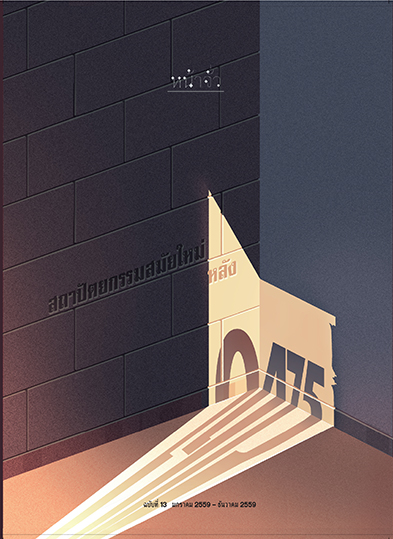อนุสาวรีย์พิทักษ์รัฐธรรมนูญ : ร่องรอยแห่งความหมายและความทรงจำ/ The Constitutional Defense Monument : Vestiges of Meanings and Memories
Main Article Content
Abstract
บทคัดย่อ
งานวิจัยชิ้นนี้ได้ทำการศึกษาอนุสาวรีย์พิทักษ์รัฐธรรมนูญในเชิงวิพากษ์ผ่านการวิเคราะห์สัญลักษณ์ การสื่อความหมายทางสถาปัตยกรรม ในประเด็นด้านการเป็นสื่อแสดงอำนาจรัฐ โดยเฉพาะอย่างยิ่งสำหรับคณะรัฐบาลภายใต้การนำของคณะราษฎรระหว่าง พ.ศ. 2475-2490, การเป็นภาพสะท้อนให้เห็นถึงอุดมการณ์ทางการเมืองของชนชั้นนำว่าด้วย “ความเป็นชาติไทย” ให้กับพลเมืองและการเป็นเครื่องมือเพื่อแสดงออกถึงเอกลักษณ์ไทย
อนึ่ง สาระของงานวิจัยซึ่งตั้งอยู่บนทฤษฎีวาทกรรมวิพากษ์และการวิเคราะห์เชิงสัญวิทยาได้เผยให้เห็นว่า การสื่อความหมายของอนุสาวรีย์พิทักษ์รัฐธรรมนูญนั้นได้ถูกกำหนดขึ้น แก้ไข เปลี่ยนแปลงไป และลบล้างลง อันเป็นผลสืบเนื่องจากการแย่งชิงอำนาจทางการเมืองภายใต้ข้ออ้างด้านอุดมการณ์ต่าง ๆ เช่น ลัทธิชาตินิยมและแนวความคิดแบบประชาธิปไตย ซึ่งในที่สุดได้นำไปสู่การลืมเลือนความหมายดั้งเดิมไปจากความทรงจำร่วมทางประวัติศาสตร์ของผู้คนในยุคปัจจุบันจนเกือบหมดสิ้น
โดยอาศัยการเสวนาเชิงวิพากษ์เกี่ยวกับการสื่อสัญลักษณ์ทางการเมืองผ่านงานสถาปัตยกรรม เนื้อหาทั้งหมดที่กล่าวมาในข้างต้นได้ถูกเรียบเรียงและนำเสนอผ่านความสัมพันธ์ในมิติต่าง ๆ อันได้แก่ อนุสาวรีย์พิทักษ์รัฐธรรมนูญกับการทำหน้าที่สถาปัตยกรรมที่สนองตอบต่อการแสดงอำนาจและความชอบธรรมทางการเมืองให้แก่รัฐ รวมทั้งปัจจัยทางการเมืองซึ่งก่อให้เกิดการเปลี่ยนแปลงความหมายและการลบเลือนความสำคัญของอนุสาวรีย์แห่งนี้ ประกอบกับความเคลื่อนไหวทางสังคมโดยภาคประชาชนที่ส่งผลให้อนุสาวรีย์พิทักษ์รัฐธรรมนูญกลับมาได้รับการจดจำในฐานะของพื้นที่แห่งความขัดแย้งและการต่อสู้ทางการเมืองอีกครั้งหนึ่ง
Abstract
This research presents a critical investigation on the Constitutional Defense Monument (Anusaowari Phithak Ratthathammanun) in Bangkok. Via discourse and iconographical analyses, the monument is examined firstly as a means of power meditation for the state, especially between 1932 and 1947 during the People’s Party administration (or the Khana Ratsadon era), secondly as a reflection of the ideological views of the ruling elites on the Thai nationhood, and thirdly as an expression of the Thai identities.
Informed by critical and semiological theories, the inquiries reveal that the symbolic significations of the Constitutional Defense Monument were created, manipulated, transformed, and disregarded by power politics under the ideological pretexts of nationalism and democracy, rendering its original meanings almost forgotten in the present collective memory of Thai citizens.
By utilizing the politics of representations as a mode of problematization, the upcoming critical and analytical discussions initially evolve around the theme of investigating the Constitutional Defense Monument in terms of a representational tool to assert, legitimize, and maintain power. The scholarly foci subsequently shift to explore the ways in which the state had semantically re-appropriated this public structure to pursue their political agenda, leading to changes of meanings and negligence of its significance. Finally, the studies concentrate on the manners in which ordinary citizens had subversively turned the monument into a contested space to practice their social and political activities.


